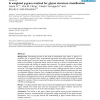1507 search results - page 100 / 302 » Separating Complexity Classes Using Structural Properties |
BMCBI
2010
13 years 10 months ago
2010
Background: Glycobiology pertains to the study of carbohydrate sugar chains, or glycans, in a particular cell or organism. Many computational approaches have been proposed for ana...
SOFTVIS
2006
ACM
14 years 4 months ago
2006
ACM
Understanding complex software systems requires getting insight in how system properties, such as performance, trust, reliability, or structural attributes, correspond to the syst...
ICIP
1998
IEEE
14 years 11 months ago
1998
IEEE
This paper introduces a new generalisation of the familiar scale-space and wavelet representations, designed specifically to deal with the complexities of representing motions ind...
GCC
2003
Springer
14 years 3 months ago
2003
Springer
A formal model called CoAuto (Cooperative Automaton) is proposed ibe and analyze cooperative processes. A basic CoAuto abstracts the behaviors of a single active entity. It separat...
JCT
2010
13 years 8 months ago
2010
Abstract. We present bijections between four classes of combinatorial objects. Two of them, the class of unlabeled (2 + 2)-free posets and a certain class of involutions (or chord ...

